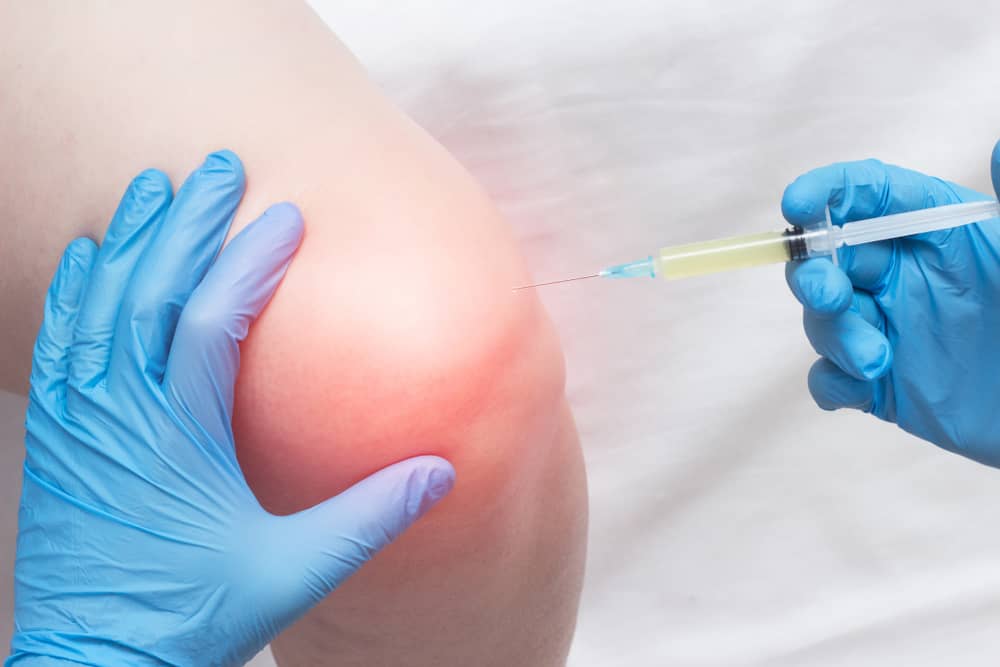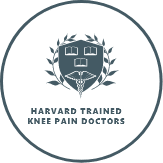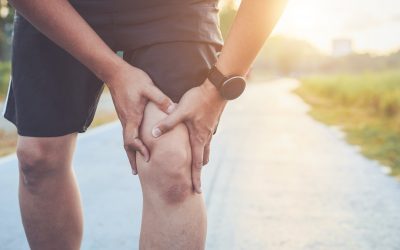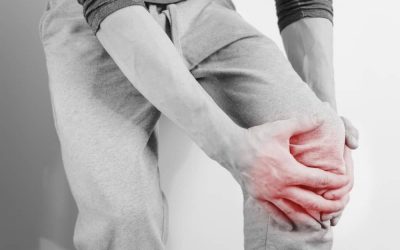6 Best Non-Surgical Knee Pain Treatment Options
Are you suffering from knee pain that’s affecting your daily life and mobility? New York Knee Pain Doctor is here to help. Our team of board-certified interventional pain doctors specializes in minimally invasive treatments to address the root cause of your knee pain. This article explores the 6 best non-surgical knee pain treatment options. We also describe why knee replacement surgery should only be a last resort.
1. RICE (Rest, Ice, Compression, Elevation)
RICE is an acronym that stands for Rest, Ice, Compression, and Elevation. It is a fundamental and initial approach to managing knee pain, especially in cases of acute injuries or inflammation. Here’s a breakdown of the components:
- Rest: Give your knee the time it needs to heal by avoiding activities that aggravate the pain. Resting your knee allows damaged tissues to repair themselves.
- Ice: Applying ice to the affected area can help reduce inflammation and alleviate pain. Use an ice pack for 15-20 minutes every 1-2 hours during the initial 48 hours after an injury.
- Compression: Wrapping a compression bandage around your knee can reduce swelling and provide support. Ensure it’s not too tight, as this could cause additional discomfort.
- Elevation: Elevating your leg can help minimize swelling because it promotes blood flow to the heart. Prop your leg up on pillows while resting to maintain a slight elevation.
RICE Benefits:
- Promotes healing by allowing injured knee tissues to recover.
- Reduces inflammation, alleviating pain and discomfort.
- Provides immediate relief and comfort after knee injuries.
- Minimizes swelling by constricting blood vessels.
- Supports the natural healing process by preventing further damage.
- Easily accessible and can be initiated at home for minor knee injuries.
- Forms the foundation of initial knee injury management protocols.
2. Nonsteroidal Anti-Inflammatory Drugs (NSAIDs)
Nonsteroidal Anti-Inflammatory Drugs (NSAIDs) are medications that reduce inflammation, alleviate pain, and improve knee joint function. They work by inhibiting enzymes responsible for inflammation and pain production. They can be taken orally or applied topically as gels or creams, providing relief from various knee conditions, such as osteoarthritis, tendinitis, and bursitis. Common NSAIDs include ibuprofen, naproxen, and aspirin.
NSAIDs Benefits:
- Reduces inflammation in the knee joint, alleviating pain and swelling.
- Improves knee joint function, allowing for increased mobility.
- Available in both over-the-counter and prescription forms.
- Provides relief from acute and chronic knee pain.
- Available in multiple forms, including oral tablets and topical creams or gels.
- Offers a non-surgical option for pain management.
3. Physical Therapy
Physical therapy is a comprehensive approach to managing knee pain. It involves a skilled physical therapist designing a tailored program to improve knee joint function and reduce pain. Therapy often includes exercises to strengthen the muscles around the knee, improve flexibility, and correct gait and posture issues. Physical therapy enhances stability, increases muscle strength and endurance, and promotes a faster recovery.
Physical Therapy Benefits:
- Tailored exercises and techniques to strengthen muscles around the knee.
- Improves flexibility and range of motion in the knee joint.
- Corrects gait and posture issues that contribute to knee pain.
- Increases muscle strength and endurance, aiding in recovery.
- Facilitates a faster and more effective rehabilitation process.
- Provides personalized care, addressing specific knee pain causes.
- Non-surgical option suitable for acute and chronic knee conditions.
4. Steroid Injections
Steroid injections contain corticosteroids, potent anti-inflammatory medications. When injected directly into the knee joint, they work by suppressing inflammation and reducing pain. Corticosteroids inhibit the immune system’s response to inflammation triggers, alleviating knee pain effectively. While they provide long-lasting benefits, they are typically limited to a few injections per year to prevent potential side effects.
Steroid Injections Benefits:
- Rapid reduction of inflammation in the knee joint, leading to pain relief.
- Provides long-lasting relief, reducing the need for frequent treatments.
- Minimizes the use of systemic medications, limiting potential side effects.
- Non-surgical approach for individuals who wish to avoid surgery.
- Enhances knee joint function and mobility.

Sick of your Knee Pain?
Book an Appointment!
We offer free insurance verification! Fill out the form and expect a call from one of our agents:
5. Viscosupplementation
Viscosupplementation is a procedure where hyaluronic acid, a gel-like substance naturally found in the synovial fluid of joints, is injected into the knee. Hyaluronic acid acts as a lubricant and shock absorber in the knee joint. When injected, it supplements the natural hyaluronic acid in the knee, providing improved lubrication and cushioning. Viscosupplementation reduces pain and enhances mobility, particularly in cases of osteoarthritis.
Viscosupplementation Benefits:
- Provides lubrication and cushioning to the knee joint, reducing friction.
- Alleviates pain associated with knee conditions, especially osteoarthritis.
- Improves joint mobility and overall function of the knee.
- Enhances shock-absorbing capabilities of the knee joint.
- Promotes better joint health by supplementing natural hyaluronic acid.
- A minimally invasive procedure with a relatively low risk of complications.
- Suitable for individuals seeking non-surgical options for knee pain.
- May reduce the need for more invasive treatments or surgery.
6. Platelet-Rich Plasma (PRP) Therapy
Platelet-Rich Plasma (PRP) therapy is an advanced non-surgical treatment option for knee pain. It involves drawing a small amount of the patient’s blood and processing it to concentrate the platelets, which contain growth factors. When injected into the knee joint, PRP stimulates tissue repair and regeneration. PRP essentially harnesses the body’s natural healing properties to heal knee injuries and joints, helping you achieve pain relief.
PRP Therapy Benefits:
- Harnesses the body’s natural healing mechanisms.
- Stimulates tissue repair and regeneration in the knee joint.
- Reduces inflammation and pain effectively.
- Potentially delays or eliminates the need for surgery.
- Uses the patient’s blood, minimizing the risk of allergic reactions or rejection.
- Promotes the healing of damaged knee tissues.
- Provides a minimally invasive option for knee pain management.
- May lead to long-lasting relief and improved knee function.
Knee Replacement Surgery (Last Resort)
Knee replacement surgery is a last resort option for severe knee joint damage. During the procedure, the surgeon removes damaged joint surfaces and replaces them with artificial implants. These implants replicate the natural structure of the knee joint, restoring its function and mobility. Knee replacement surgery offers significant pain relief and a long-term solution for advanced knee joint degeneration, but it should only be considered if all minimally invasive procedures fail to yield the desired results.
Knee Replacement Surgery Drawbacks:
- Invasive procedure with inherent surgical risks.
- Prolonged recovery period, requiring rehabilitation and physical therapy.
- Permanent alteration of the knee joint anatomy.
- Limited options for revision surgery if complications arise.
- Significant post-operative pain and discomfort.
- Costly procedure, including hospitalization, surgeon’s fees, and anesthesia.
- May not be suitable for individuals with certain medical conditions or advanced age.
- No guarantee of complete pain relief or restoration of full mobility.

Find Your Nearest Knee Pain Treatment Center
Our Manhattan NY knee pain clinic is conveniently located on 290 Madison Avenue Suite 203
Knee Pain Treatment FAQs
What are the common causes of knee pain?
Knee pain can be caused by various factors, including osteoarthritis, rheumatoid arthritis, tendinitis, bursitis, ligament injuries, and meniscus tears.
When should I consider non-surgical knee pain treatments?
Non-surgical treatments are typically recommended for individuals with mild to moderate knee pain or those looking to avoid surgery.
What are the advantages of non-surgical treatments over surgery?
Non-surgical treatments are less invasive, involve shorter recovery times, and carry fewer risks compared to surgery. They also preserve your natural knee joint as much as possible.
Are non-surgical treatments effective for all types of knee pain?
Non-surgical treatments can be highly effective for many types of knee pain, including osteoarthritis, tendinitis, and bursitis. However, their effectiveness depends on the individual and the specific condition.
How do I know which non-surgical treatment is right for me?
The choice of treatment depends on your diagnosis, the severity of your knee pain, and your medical history. A board-certified interventional pain doctor can assess your condition and recommend the most suitable treatment.
Do non-surgical treatments provide long-term relief?
The duration of pain relief varies depending on the treatment and the individual. Some treatments can offer long-lasting benefits, while others may require periodic maintenance.
Can non-surgical treatments be combined for better results?
Yes, in some cases, a combination of non-surgical treatments may be recommended to maximize pain relief and improve knee function. Your doctor will create a customized treatment plan based on your needs.
Is physical therapy painful, and how long does it take to see results?
Physical therapy is tailored to your specific needs and pain tolerance. While some exercises may initially cause discomfort, they are designed to improve your condition. Results vary, but many patients start experiencing improvements within a few weeks.
What is the recovery time after viscosupplementation or PRP therapy?
Recovery times for viscosupplementation and PRP therapy are relatively short. You may experience some discomfort at the injection site for a few days, but most patients can resume their normal activities within a week or so.
When should I consider knee replacement surgery as a last resort?
Knee replacement surgery should be considered when non-surgical treatments have not provided adequate pain relief and your knee pain significantly impairs your quality of life. Your doctor will discuss surgical options and help you make an informed decision.
When to Consult New York Knee Pain Doctor
If you’re experiencing persistent knee pain that limits your daily activities, it’s crucial to seek professional medical advice. At New York Knee Pain Doctor, we prioritize minimally invasive pain treatments, ensuring that you receive the most suitable and effective care without resorting to opioids or surgery. Our board-certified interventional pain doctors are dedicated to diagnosing the root cause of your knee pain and tailoring a personalized treatment plan for your needs.
If you experience any of the following symptoms, it’s crucial to seek professional help promptly:
- Severe pain that limits your mobility.
- Persistent swelling or redness around the knee joint.
- Instability or weakness in the knee.
- Difficulty bearing weight on the affected leg.
- Pain that does not improve with rest and over-the-counter pain medications.
Our team of board-certified interventional pain doctors is dedicated to providing comprehensive care and free insurance verification before your first appointment, ensuring you have access to the best non-surgical knee pain treatments available. Please schedule an appointment to explore your non-surgical knee pain treatment options in New York.
FEATURED POSTS BY PAIN DOCTORS
Find a Doctor for Knee Pain at Brighton Beach, NY
Find a Doctor for Knee Pain at Brighton Beach, NYKnee pain can make even the simplest tasks feel like monumental challenges. Whether it’s the sharp pain you feel when climbing stairs, the nagging discomfort after walking for a while, or the stiffness that sets in...
Find the Best Knee Pain Doctor in Brighton Beach, NY
Find the Best Knee Pain Doctor in Brighton Beach, NYKnee pain can be a daily struggle that affects everything from your morning jog to simply walking up the stairs. If you’ve been experiencing knee discomfort, stiffness, or swelling, you know how it can limit your...
Knee Pain Treatment: What to Expect and What to Avoid
Knee Pain Treatment: What to Expect and What to AvoidIf you're reading this article, chances are you or someone you know is experiencing knee pain, and you're seeking answers on how to effectively manage and treat it. At New York Knee Pain Doctor, led by...
The Benefits of Knee Pain Treatment for Athletes
The Benefits of Knee Pain Treatment for AthletesAre you an athlete struggling with knee pain, desperately searching for relief and a way to get back to your peak performance? At New York Knee Pain Doctor, we understand the unique challenges athletes face when dealing...
Meet Our Team of Knee Pain Specialists
KNOW OUR TEAM OF HARVARD TRAINED KNEE SPECIALISTS

Knee Pain Doctor in New York
Dr. Michael Nguyen
Dr. Michael is available for Knee Pain treatment consultations in Manhattan, New York.

Knee Pain Doctor in New Jersey
Dr. George Hanna
Dr. Hanna is available for Knee Pain treatment consultations in Manhattan, New York.

Knee Pain Doctor in New York
Dr. Shane Volney
Dr. Volney is available for Knee Pain treatment consultations in Manhattan, New York.
Keeping you safe during COVID-19
Learn about our health & safety protocol.







contact us today
Call us
Speak instantly with one of our team members; they will answer any questions you may have regarding insurance coverage, booking an appointment and our knee pain center in New York and New Jersey.
Book Online
Visit our Book Appointment page and instantly request an appointment at our Manhattan knee pain clinic. We offer Free Insurance Verification before your appointment.
Get directions
Learn how to easily get to the Knee Pain Clinic nearest you.




